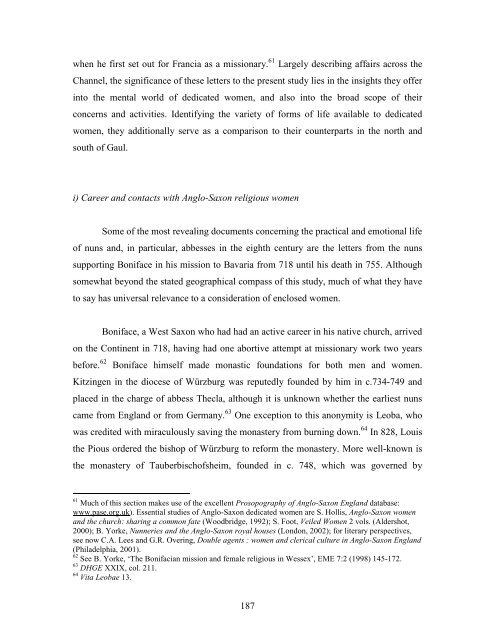Lindsay Rudge PhD Thesis - University of St Andrews
Lindsay Rudge PhD Thesis - University of St Andrews
Lindsay Rudge PhD Thesis - University of St Andrews
You also want an ePaper? Increase the reach of your titles
YUMPU automatically turns print PDFs into web optimized ePapers that Google loves.
when he first set out for Francia as a missionary. 61 Largely describing affairs across the<br />
Channel, the significance <strong>of</strong> these letters to the present study lies in the insights they <strong>of</strong>fer<br />
into the mental world <strong>of</strong> dedicated women, and also into the broad scope <strong>of</strong> their<br />
concerns and activities. Identifying the variety <strong>of</strong> forms <strong>of</strong> life available to dedicated<br />
women, they additionally serve as a comparison to their counterparts in the north and<br />
south <strong>of</strong> Gaul.<br />
i) Career and contacts with Anglo-Saxon religious women<br />
Some <strong>of</strong> the most revealing documents concerning the practical and emotional life<br />
<strong>of</strong> nuns and, in particular, abbesses in the eighth century are the letters from the nuns<br />
supporting Boniface in his mission to Bavaria from 718 until his death in 755. Although<br />
somewhat beyond the stated geographical compass <strong>of</strong> this study, much <strong>of</strong> what they have<br />
to say has universal relevance to a consideration <strong>of</strong> enclosed women.<br />
Boniface, a West Saxon who had had an active career in his native church, arrived<br />
on the Continent in 718, having had one abortive attempt at missionary work two years<br />
before. 62 Boniface himself made monastic foundations for both men and women.<br />
Kitzingen in the diocese <strong>of</strong> Würzburg was reputedly founded by him in c.734-749 and<br />
placed in the charge <strong>of</strong> abbess Thecla, although it is unknown whether the earliest nuns<br />
came from England or from Germany. 63 One exception to this anonymity is Leoba, who<br />
was credited with miraculously saving the monastery from burning down. 64 In 828, Louis<br />
the Pious ordered the bishop <strong>of</strong> Würzburg to reform the monastery. More well-known is<br />
the monastery <strong>of</strong> Tauberbisch<strong>of</strong>sheim, founded in c. 748, which was governed by<br />
61 Much <strong>of</strong> this section makes use <strong>of</strong> the excellent Prosopography <strong>of</strong> Anglo-Saxon England database:<br />
www.pase.org.uk). Essential studies <strong>of</strong> Anglo-Saxon dedicated women are S. Hollis, Anglo-Saxon women<br />
and the church: sharing a common fate (Woodbridge, 1992); S. Foot, Veiled Women 2 vols. (Aldershot,<br />
2000); B. Yorke, Nunneries and the Anglo-Saxon royal houses (London, 2002); for literary perspectives,<br />
see now C.A. Lees and G.R. Overing, Double agents : women and clerical culture in Anglo-Saxon England<br />
(Philadelphia, 2001).<br />
62 See B. Yorke, ‘The Bonifacian mission and female religious in Wessex’, EME 7:2 (1998) 145-172.<br />
63 DHGE XXIX, col. 211.<br />
64 Vita Leobae 13.<br />
187

















